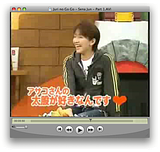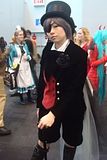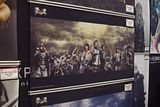
(Click to enlarge)
In this example, the guests had been asked to describe some quality of their top star, Aran Kei, pictured above. One of the shows she had done was "El Halcon," a musical on pirates based on the Aoike Yasuko manga of the same name. The movie "Pirates of the Caribbean" came up in the conversation and Aran Kei was teasing her troupe members by implying that they thought of her as the "octopus person," Davy Jones.
At first, I had thought that the reason why タコ was used instead of たこ was because it was combined with 人 and thus created something that was fantastical and not real. However, after speaking with Park-sensei, I learned that animal and plant names are often written in katakana (i.e. バラ for "rose"). It's a good way to show when one is speaking generically, as opposed to a specific type (i.e. umbrella octopus) that would most likely have hiragana/kanji.

(Click to enlarge)
This example features Sena Jun, former top star of Yukigumi (Moon Troupe) and requires a little background on the Takarazuka Revue's practice in regards to names. During their time at the Takarazuka Revue Company, all Takarasiennes are known only by their stage names. Personal information such as their real name and age are actually kept secret (part of what falls under what is called the "Sumire Code") until a Takarasienne's retirement. Sena Jun retired in 2009 and her real name, Doi Asako (土井麻子), has since been released to the public.
Nicknames, however, can be derived by either a Takarasienne's real name (Sena Jun's nickname: Asako), stage name (Juri Sakiho's nickname: Juri) or something else entirely (Takumi Hibiki, former top star of Hanagumi (Flower Troupe): Charlie, because of her bicycle). In this example, the caption is of Juri's words of praise for Sena, but she uses Sena's nickname, "Asako." I was surprised to see it written アサコ instead of あさこ simply because it's a common female name. I at first thought that because of Takarazuka's policy that Takarasiennes primarily go by their stage names, the use of katakana denoted the name as "unofficial." However, speaking again with Park-sensei revealed that it was more than likely used because her real name uses kanji and not hiragana (麻子).
All of these intricacies make it quite difficult to place definitive rules on the usage of katakana. This can explain why textbooks may explain this usage of katakana in different ways. Most note that katakana is often used for foreign words and onomatopoeia, however, some add reasons why they are used. For example, the last excerpt from our handout notes that "foreign loanwords give an impression of sophistication and modernity" and are used "even when a perfectly good native Japanese word exists." Another example spoke of the use of katakana as onomatopoeia that can both express "natural sounds (meow, bang, etc.)" and "manner (twinkle, zigzag, etc.)." These explanations aren't necessarily different from each other, but simply add a depth to one's understanding of how katakana can be used.




















